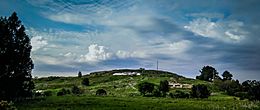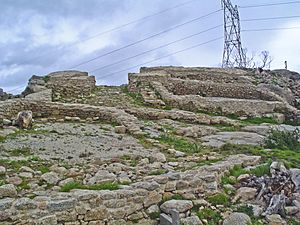Castro de Elviña facts for kids
Quick facts for kids Castro of Elviña |
|
|---|---|
| Native name Galician: Castro de Elviña |
|

The hill fort in 2015
|
|
| Official name: Castro de Elviña | |
| Type | Non-movable |
| Criteria | Monument |
| Designated | 1962 |
| Lua error in Module:Location_map at line 420: attempt to index field 'wikibase' (a nil value). | |
The Castro of Elviña (pronounced KAS-tro day el-VEEN-ya) is an ancient village built on a hill. It's called a hill fort and was made during the Iron Age. This means people lived here thousands of years ago, when tools were made of iron. You can find this historic site south of the city of A Coruña in Galicia, Spain. Because it's so important, it was officially named a historic monument in 1962.
Contents
What is the Castro of Elviña?
A "castro" is a type of fortified village. These villages were common in Galicia and other parts of Europe during the Iron Age. People built them on hills for protection. The Castro of Elviña is one of the most famous examples in Galicia. It shows us how people lived and defended themselves long ago.
Life in an Iron Age Hill Fort
Imagine living in a village surrounded by strong walls! That's what life was like at the Castro of Elviña. People built their homes inside these walls. These homes were usually round or oval-shaped. They had roofs made of straw or other natural materials. The walls of the castro helped protect the villagers from enemies. They also kept their animals safe.
People living here were part of the Castro culture. This culture was known for its unique art and way of life. They were skilled farmers and craftspeople. They made pottery, metal tools, and jewelry. The people of the Castro culture were also called the Gallaeci.
Discovering the Castro
Archaeologists have been studying the Castro of Elviña for many years. They dig carefully to find old buildings, tools, and other objects. These discoveries help us learn about the daily lives of the people who lived there. They've found remains of houses, walls, and even streets. This shows that Elviña was a well-organized community.
The site is still being explored today. Each new discovery helps us understand more about the Iron Age in Spain. It's like a giant puzzle, and archaeologists are putting the pieces together.
See also
 In Spanish: Castro de Elviña para niños
In Spanish: Castro de Elviña para niños
- Castro culture
- Gallaeci
- List of castros in Galicia


